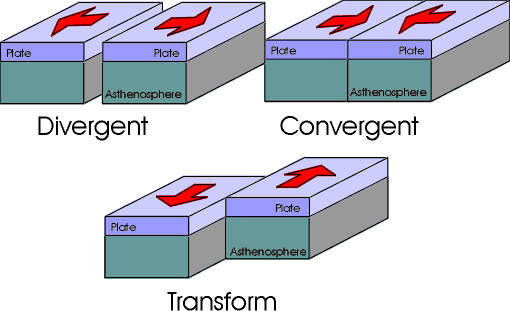The earth’s lithosphere (the rigid, outershell of the planet) is broken up in to several fragments, called tectonic plates. Earthquakes are caused by the movement of these plates, most commonly where two or more plates meet (interplate earthquakes). However, earthquakes can also occur away from plate boundaries (intraplate earthquakes), but these are less common.
There are three types of plate boundaries; convergent, divergent and transform. See diagram below.
The movement of one plate can cause it to push or rub against another, in a variety of ways. Any irregularities or asperities along the margin can cause a type of stick-slip behavior (a spontaneous jerking motion). Once the plate is locked in place, any continued movement will result in a build up of stress, which is eventually released as energy, causing an earthquake. This point of origin is called an hypocentre. The epicentre is the location vertically above the hypocentre on the earth’s surface.
This type of behavior can also occur along fault lines. A fault is a fracture through a section of the earth’s crust. They are the result of tectonic plate movement (the largest forming at the plate margins). Usually, the rocks on either side of the fracture are moving too slowly for us to notice, but stress can build up, resulting in a sudden release of potential energy; an earthquake.
The three main types of faults are named for how the adjacent segments of rock are aligned next to one another; normal, reverse (also known as thrust) and strike-slip (see figure 2 below). Normal and reverse/thrust faults are both types of dip-slip; displacement along the fault is dipping in one direction, and movement along them is vertical. Strike-slip faults require horizontal movement past each other. Reverse faults generally cause the largest earthquakes (occurring most frequently along convergent plate margins).
A study on the San Andreas Fault (Coppersmith & Schwatz 1984) has found that earthquakes that occur along the same fault line will generally be of a similar magnitude.


